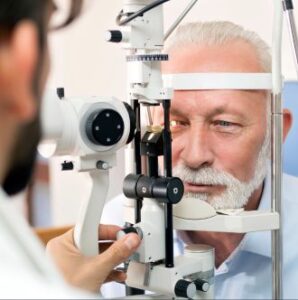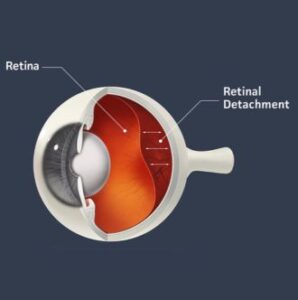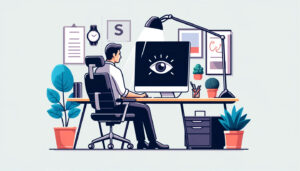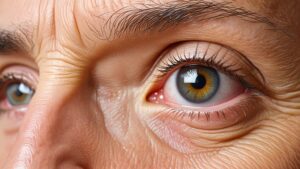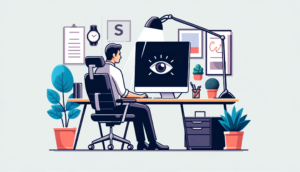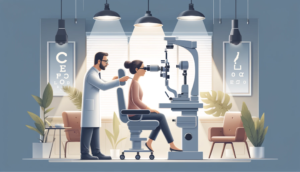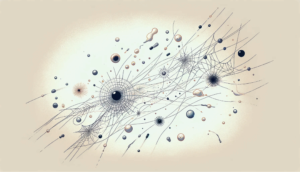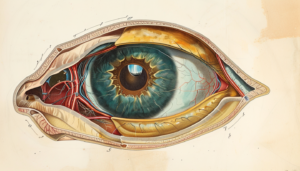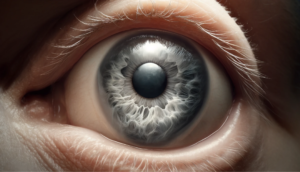Dry eye disease affects hundreds of millions of people around the world. The symptoms can range from being mildly irritating and inconvenient to quite severe, causing extreme pain and discomfort, restriction of daily activities and decreased general health. [9]
Dry eye disease is referred to as a multifactorial disease, meaning that it includes a spectrum of clinical findings and symptoms resulting from complex processes involving the surface of the eye (ocular surface). The term “ocular surface” includes the tear film, lacrimal glands, meibomian glands, cornea, conjunctiva, and eyelids.
Identifying the cause of someone’s dry eye disease can lead to more efficient treatment strategies. Many experts use a step-wise approach to treat their patients with dry eye symptoms. This approach means that treatment often begins with the simplest least invasive treatment option, such as artificial tears, and if this does not provide any relief of symptoms, they will suggest increasingly more intensive treatments until a solution is found. [3]
There are most commonly two types of dry eye disease, aqueous deficient dry eye (eye does not produce enough tears) and evaporative dry eye (poor quality tears that evaporate from the eye surface too quickly). Determining which one someone has can identify the best treatment to use.
The goal of treatment is to return the surface of the eye to a normal, balanced state, eliminating ongoing inflammation and discomfort. This can be achieved in three ways; increasing the amount of tears or liquid on the eye surface, reducing tear evaporation, and improving the quality of tears (often by increasing lipid content or lubrication). Although short-term treatments may provide relief of symptoms, it is important to consider any long-term effects that chronic dry eye may have had on overall eye health.
WHAT ARE SOME COMMON TREATMENT OPTIONS FOR DRY EYE DISEASE?
- Artificial tears
- Nutritional supplements
- Lifestyle changes
- Warm compresses
- Prescription eye drops and inserts (Restasis®, Xiidra®, Steroid eye drops, Lacrisert®)
- Punctal plugs
- Meibomian gland expression
- Lipiflow®
- Intense pulsed light (IPL)
ARTIFICIAL TEARS
There are numerous artificial tear products that are available over-the-counter (OTC), not requiring prescription. These eye drops often provide temporary relief of symptoms because they attempt to replace or supplement a lack of natural tears by delivering moisture and lubrication to the eye surface. Some also promote healing of inflammation that has occurred on the eye surface. There are several brands available, so it is important to carefully read the package and make sure that it is right for you. Many people find that they must try several different brands or different formulations to find an eye drop that works best for their symptoms.
Some artificial tear brands contain preservatives. Preservatives are added chemicals that help prevent bacteria from growing in the artificial tears once the sterile seal on the artificial tear bottle has been broken. Some people can experience irritation from the added preservatives.
Preservative-free artificial tears usually have less added ingredients and often come in smaller or single-use containers. These artificial tear products are usually recommended for people that use drops several times per day.
Artificial tears can cause blurred vision because many contain ingredients that thicken the drops to help keep them on the eye surface longer. Some tear products are also available in gel, ointment, or gel insert form and likely cause blurred vision, so it is generally recommended to use these types of products at bedtime or when clear vision is not required.
NUTRITIONAL SUPPLEMENTS
Many eyecare providers have noted clinical improvement in their patients with dry eye disease that have started taking omega-3 supplements. Omega fatty acids are not produced by the body, so they must be obtained through diet or vitamin supplements. Eye Care professionals commonly recommend omega supplements for dry eye symptom relief.
A 2019 meta-analysis of 17 randomized clinical trials (3363 people with dry eye disease) reported that supplementation with omega-3 fatty acid significantly improves dry eye signs and symptoms. The researchers concluded that these findings indicate that Omega-3 fatty acid supplementation may be an effective treatment for dry eye disease. [4]
HOW CAN OMEGA-3 SUPPLEMENTS HELP WITH DRY EYE?
Omega-3 fatty acids appear to improve the lipid layer on the surface of the eye, which helps the eye stay lubricated and tears evaporate more slowly. Normally lipids are delivered to the eye surface by small glands at the edge of the eyelids, called meibomian glands. Omega-3 fatty acids also play a key role in the body’s ability to regulate and balance inflammation.
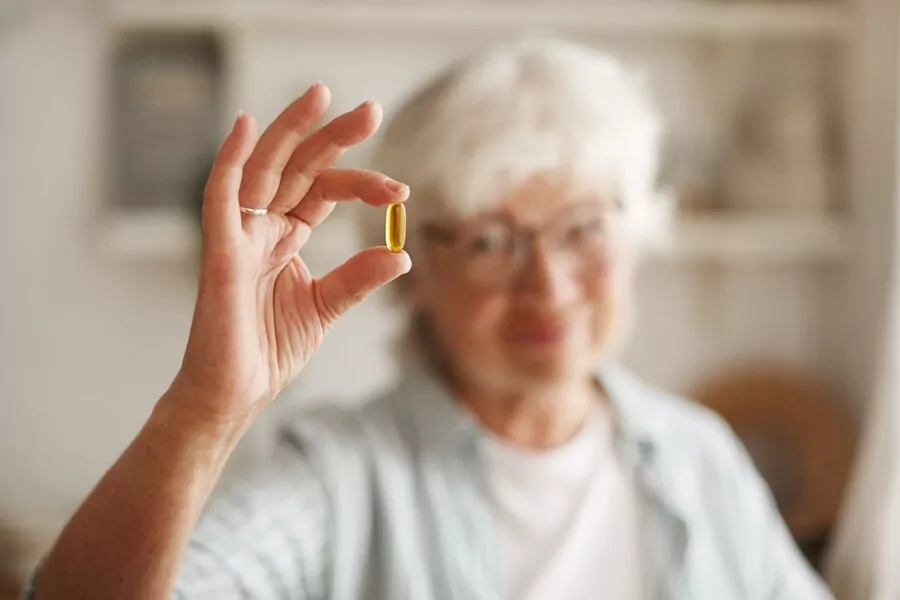
ARE OMEGA-3 SUPPLEMENTS SAFE?
When taken as directed on the package instructions, most omega-3 supplements have few side effects and are generally safe. It is always important to discuss starting any new medication or dietary supplement with your primary care physician, especially for people that have any other health concerns or are taking other medication. High doses of omega-3 can be harmful and may lead to increased bleeding risk, increased low-density lipoprotein (LDL) cholesterol, and blood sugar control problems. A fishy aftertaste or odor is common in omega-3 supplements derived from fish.
DO ALL OMEGA-3 SUPPLEMENTS CONTAIN FISH OIL?
There are excellent sources of Omega-3 available that do not contain fish oil. Supplements containing omega-3 algal oil, sustainably sourced from algae, is a vegan source of essential fatty acids in one of the purest forms. Omega-3 from algae eliminates any concerns related to environmental pollutants such as mercury, dioxins and industrial chemicals such as polychlorinated biphenyls (PCBs) that have been associated with consumption of fish products. Algae is the original source of Omega-3 consumed by fish, but free of potential chemical and other contaminants that accumulate in fish over their lifetime.
CAN CHANGES IN LIFESTYLE IMPROVE DRY EYE?
Some people can find relief from symptoms of dry eye disease with small lifestyle changes. Studies have shown that lifestyle factors related to screen time, physical activity and sedentary behavior, and even happiness have been associated with tear production and quality. [5]
Taking regular breaks from reading or screen time can help to improve dry eye symptoms because these activities lead to less frequent blinking. Blinking is the opportunity for tears to redistribute moisture and lubrication across the eye surface.
Dry eye symptoms may be more common for people who wear contact lenses. Wearing contact lenses for shorter periods or changing the type of brand of contact lenses may help to alleviate symptoms.
WARM COMPRESSES
The glands at the edge of the eyelid (the meibomian glands) are responsible for delivering healthy lipids to the eye surface to keep the eye lubricated but can sometimes become clogged. In some cases, applying warm compresses to closed eyes can help to soften the clogged gland.
In order to be effective, warm compresses need to be maintained at a temperature of between 104°F and 108°F for 10 minutes or more. Maintaining an adequate temperature for that period of time can be difficult for some people. An important warning: warmer is not better when applying warm compresses to the eye and damage or injury can occur to the eye or eyelid at higher temperatures. [2]
ARE THERE PRESCRIPTION OPTIONS FOR DRY EYE?
Prescription eye drops, ointments, gels and inserts are available that are similar to artificial tears, but have added medicinal ingredients such as anti-inflammatories or steroids to treat the underlying causes of dry eye.
Restasis® is an eye drop that contains an anti-inflammatory and has been shown to help eyes produce more tears and improve symptoms of dry eye. Improvement in symptoms can take up to 3 months of daily use and some people report increased redness and burning sensation.

Xiidra® is another prescription eye drop that when taken twice daily, has shown to provide relief of dry eye symptoms. Side effects of Xiidra® have included eye irritation, altered taste sensation, and changes in vision.
Physicians may prescribe steroid eye drops, often for a short period of time, to manage dry eye symptoms and underlying inflammation. Steroid eye drops can be used in addition to artificial tears or other prescription drops. Steroid eye drops are available in varying strengths or potencies and people are initially prescribed a lower potency to start and increase if needed. Risk associated with steroid eye drops increase when used for longer periods of time and can include increased pressure inside the eye, cataract formation, and corneal damage.
Eye lubricating inserts (Lacrisert®) may also be prescribed. Once daily, a small, solid insert is placed inside the outer corner of the lower eyelid against the surface of the eye. Over the course of the day it slowly releases preservative-free lubricant as the solid insert liquifies.
WHAT ARE PUNCTAL PLUGS?
A punctum (plural puncta) is the tiny opening at the inner corner of the upper or lower eyelid, often called tear ducts. An Eye Care professional can insert tiny sterile plugs (punctal plugs) into these openings to keep tears, either natural or artificial, from draining away and on the surface of the eye longer. If tears are not able to drain, they often will evaporate. If eyes appear too watery, then a punctal plug may have to be removed.
Punctal Plugs are used to stop tears from draining too quickly, treating dry eye disease.
Punctal plugs can be used as a temporary or long-term solution of dry eye and can be inserted in the doctor’s office. The procedure to insert plugs is only mildly uncomfortable and most people do not feel the plugs once inserted.
Temporary plugs are made of collagen and often used for a trial period to see if it is a good solution to someone’s dry eye symptoms. Collagen plugs will eventually dissolve over a period of weeks or months. More permanent punctal plugs are often made of medical silicone or acrylic and will last for years, until they are removed. Another more permanent plug that may be considered is an intracanular plug, which is inserted farther into the punctum and far more difficult to remove.
WHAT IS MEIBOMIAN GLAND PROBING OR EXPRESSION?
The meibomian glands are a series of small glands on the rims of the upper and lower eyelids that secrete the lubricating lipids that help to prevent tears from evaporating from the eye surface. There are approximately 25 to 40 glands on the upper eyelid and 20 to 30 on the lower. When these glands are not functioning properly or are blocked, it is referred to as Meibomian Gland Dysfunction (MGD), one of the most common forms of dry eye disease.
If the meibomian gland is blocked, tears will evaporate too quickly, resulting in dry eye disease.
To express the glands, tiny spatulas or rollers are placed above and below one of the eyelids and the contents are squeezed out. The pressure required to squeeze the contents out of the gland range from 5 psi and 40 psi. [10] Unfortunately, only 7% of patients could tolerate the pressure necessary to achieve complete therapeutic expression. [6]
Probing of the glands is considered preferable to expression and is effective for more than 70% of patients. [8] It involves a tiny probe being inserted 1 to 2 mm into the glands to help relieve any blockage and allow lipids to reach the eye surface. Anesthetic can be applied to the eyelids to alleviate any pain of the procedure.
WHAT IS LIPIFLOW®?
LipiFlow® is an in-office treatment for dry eye that combines warm compresses and expression of the meibomian glands. Normal function of the glands is required to ensure that tears contain the right balance of lipids to keep the surface of the eye lubricated and prevent tears from evaporating too quickly. LipiFlow® is a Thermal Pulsation System, which means that when the device is fitted over the eyelids it delivers pulsed pressure while warming the eyelids to the required temperature for effective gland expression.
Studies have shown that 79-86% of people that received LipiFlow® treatment experienced an improvement in their dry eye symptoms and the positive effects were maintained for 1 year. [1, 7] Some people have experienced mild pain or discomfort, during and after the procedure, and a small number experienced an irritation to eyelid skin.
The procedure is not usually covered by health insurance and associated costs are approximately $700 per eye but can vary depending on the practitioner.
HOW DOES INTENSE PULSED LIGHT (IPL) TREAT DRY EYE?
Intense pulse light (IPL) is a treatment that uses a device that delivers flashes of bright light, at a very specific wavelengths, onto small areas of the skin. The device and procedure are FDA approved for treatment of inflammatory skin conditions like rosacea. Some people that have rosacea also experience dry eye symptoms because of the inflammation that occurs when the tiny blood vessels along the edge of the eyelids become dilated. IPL reduces the inflammation in the vessels around the eye.
Many people report feeling some relief of their dry eye symptoms after IPL therapy and are less reliant on artificial tears. Four to six treatments of IPL below the eyes are typically required, usually several weeks apart. IPL may not be used for people with darkly pigmented skin.
Patients are instructed to wear sunscreen for three weeks or limit their time outdoors after IPL treatment to avoid undoing the effects of the treatment.
REFERENCES:
[1] Blackie CA, Coleman CA, Holland EJ. The sustained effect (12 months) of a single-dose vectored thermal pulsation procedure for meibomian gland dysfunction and evaporative dry eye. Clin Ophthalmol. 2016 Jul 26;10:1385-96. https://www.ncbi.nlm.nih.gov/pubmed/27555745
[2] Bron AJ, Tiffany JM, Gouveia SM, et al. Functional aspects of the tear film lipid layer. Exp Eye Res. 2004 Mar;78(3):347-60. https://www.ncbi.nlm.nih.gov/pubmed/15106912
[3] Craig JP, Nichols KK, Akpek EK, Caffery B, Dua HS, Joo CK, Liu Z, Nelson JD, Nichols JJ, Tsubota K, Stapleton F. TFOS DEWS II Definition and Classification Report. Ocul Surf. 2017;15:276–283. https://www.ncbi.nlm.nih.gov/pubmed/28736335
[4] Giannaccare G, Pellegrini M, Sebastiani S, Bernabei F, Roda M, Taroni L, Versura P, Campos EC. Efficacy of Omega-3 Fatty Acid Supplementation for Treatment of Dry Eye Disease: A Meta-Analysis of Randomized Clinical Trials. Cornea. 2019 Jan 29. doi: 10.1097/ICO.0000000000001884. https://www.ncbi.nlm.nih.gov/pubmed/30702470
[5] Kawashima M, Sano K, Takechi S, Tsubota K. Impact of lifestyle intervention on dry eye disease in office workers: a randomized controlled trial. J Occup Health. 2018 Jul 25;60(4):281-288. https://www.ncbi.nlm.nih.gov/pubmed/29618677
[6] Korb DR, Blackie CA. Meibomian gland therapeutic expression: quantifying the applied pressure and the limitation of resulting pain. Eye Contact Lens. 2011;37(5):298–301. https://www.ncbi.nlm.nih.gov/pubmed/21617536
[7] Lane SS, et al. A new system, the LipiFlow, for the treatment of meibomian gland dysfunction. Cornea. 2012;31 (4):396-404. https://www.ncbi.nlm.nih.gov/pubmed/22222996
[8] Maskin SL. Intraductal meibomian gland probing relieves symptoms of obstructive meibomian gland dysfunction. Cornea. 2010;29(10):1145–1152. https://www.ncbi.nlm.nih.gov/pubmed/20622668
[9] Na KS, Han K, Park YG, Na C, Joo CK. Depression, Stress, Quality of Life, and Dry Eye Disease in Korean Women: A Population-Based Study. Cornea. 2015;34:733–738. https://www.ncbi.nlm.nih.gov/pubmed/26002151
[10] Opitz D, Harthan J, Fromstein S, Hauswirth S. Diagnosis and management of meibomian gland dysfunction: optometrists’ perspective. Clinical Optometry. Volume 2015:7 Pages 59—69 https://www.dovepress.com/diagnosis-and-management-of-meibomian-gland-dysfunction-optometrists39-peer-reviewed-article-OPTO

